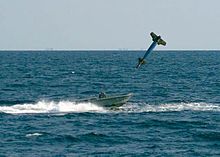Guided bomb

A guided bomb (also known as a smart bomb, guided bomb unit, or GBU) is a precision-guided munition designed to achieve a smaller circular error probable (CEP).[1][2]
The creation of precision-guided munitions resulted in the retroactive renaming of older bombs as unguided bombs or "dumb bombs".
Guidance
Guided bombs carry a guidance system which is usually monitored and controlled from an external device. A guided bomb of a given weight must carry fewer explosives to accommodate the guidance mechanisms.
Radio
The Germans were first to introduce Precision Guided Munitions (PGMs) in combat, using the 1,400-kg (3,100 lb)
The United States Army Air Forces used similar techniques with Operation Aphrodite, but had few successes; the German Mistel (Mistletoe) "parasite aircraft" was no more effective.
The U.S. programs restarted in the
Although not as popular as the newer
Infrared
In World War II, the U.S. National Defense Research Committee developed the VB-6 Felix, which used infrared to home on ships. While it entered production in 1945, it was never employed operationally.[4]
Laser

In 1962, the US Army began research into laser guidance systems and by 1967 the USAF had conducted a competitive evaluation leading to full development of the world's first laser-guided bomb, the BOLT-117, in 1968. All such bombs work in much the same way, relying on the target being illuminated, or "painted," by a laser target designator on the ground or on an aircraft. They have the significant disadvantage of not being usable in poor weather where the target illumination cannot be seen, or where it is not possible to get a target designator near the target. The laser designator sends its beam in a series of encrypted pulses so the bomb cannot be confused by an ordinary laser, and also so multiple designators can operate in reasonable proximity.
Laser-guided weapons did not become commonplace until the advent of the microchip. They made their practical debut in Vietnam, where on 13 May 1972 when they were used in the second successful attack on the Thanh Hoa Bridge ("Dragon's Jaw"). This structure had previously been the target of 800 American sorties
There are two basic families of laser-guided bombs in American (and American-sphere) service: the
Satellite
Lessons learned during the first Gulf War showed the value of precision munitions, yet they also highlighted the difficulties in employing them—specifically when visibility of the ground or target from the air was degraded.

The precision of these weapons is dependent both on the precision of the measurement system used for location determination and the precision in setting the coordinates of the target. The latter critically depends on intelligence information, not all of which is accurate. According to a CIA report, the accidental
History
The guided bomb had its origins in World War II. Its usage increased after the success of the weapon in the Gulf War.
World War II
In World War II, the aforementioned Fritz X and
Korean War
The US briefly deployed the ASM-A-1 Tarzon (or VB-13 Tarson) bomb (a Tallboy fitted with radio guidance) during the Korean War, dropping them from Boeing B-29 Superfortresses.
Vietnam War
In 1962, the US Army began research into laser guidance systems and by 1967 the USAF had conducted a competitive evaluation leading to full development of the world's first laser-guided bomb, the BOLT-117, in 1968.
Gulf War
War on Terror
Lessons learned during the first Gulf War showed the value of guided bombs, with precision-guided munitions accounting for 70% of munitions expended during Operation Enduring Freedom.[12]
Advanced guidance concepts
Responding to after-action reports from pilots who employed laser and/or satellite guided weapons,
See also
- M1156 Precision Guidance Kit
- M982 Excalibur
- XM395 Precision Guided Mortar Munition
- M712 Copperhead
- Krasnopol (weapon system)
- Strix mortar round
- Cruise missile
- Wire-guided missile
- Glide bomb
- Precision-guided munition
- Guidance system
- Missile
- Missile guidance
- Terminal guidance
- Proximity sensor
- Artillery fuze
- Magnetic proximity fuze
- Proximity fuze
Notes
- ^ Hamilton, Richard (1995). "Precision guided munitions and the new era of warfare". Air Power Studies Centre, Royal Australian Air Force. Retrieved 2009-02-02.
- British Pathénewsreel 52/51A, June 23, 1952. Accessed 2013-04-04.
- ^ Fitzsimons, op. cit., Volume 10, p.1090, "Gargoyle".
- ^ Fitzsimons, op. cit., Volume 9, p.926, "Felix".
- ^ Thanh Hoa Bridge Archived 2005-11-09 at the Wayback Machine
- ^ Britain's Small Wars Archived 2011-01-20 at the Wayback Machine
- ^ JDAM continues to be warfighter's weapon of choice
- ^ U.S. Air Force Factsheets: Joint Direct Attack Munition
- ^ JDAM Specifications
- ^ DCI Statement on the Belgrade Chinese Embassy Archived 2006-10-04 at the Wayback Machine
- ^ Fitzsimons, op. cit., Volume 9, p.926, "Felix".
- ^ Lambeth, Benjamin S. (2005). "Air Power Against Terror: America's Conduct of Operation Enduring Freedom" (PDF). RAND Corporation. Archived (PDF) from the original on 2014-10-21.
- ^ Boeing Laser JDAM Archived 2006-05-22 at the Wayback Machine
- ^ Raytheon Enhanced Paveway Archived 2008-03-07 at the Wayback Machine
External links
- "Bomb With A Brain". British Pathénewsreel 52/51A, June 23, 1952.
- How Smart Bombs Work
- A Brief History of Precision Guided Weapons
- "Smart bombs" missed Iraqi targets BBC story on the first employment of the JSOW, guidance failures were attributed to a software error that was subsequently fixed.
- "Fact File: Smart Bombs - not so Smart BBC story discussing the limitations of guided munition employment.
- Ukraine develops indigenous guided airborne weapons Article about Ukrainian guided bomb development, August 2006
- "World War II Glide Bombs World War II Glide Bombs (Part1)
- "World War II Glide Bombs World War II Glide Bombs (Part2)
- "World War II Glide Bombs Modern Glide Bombs
